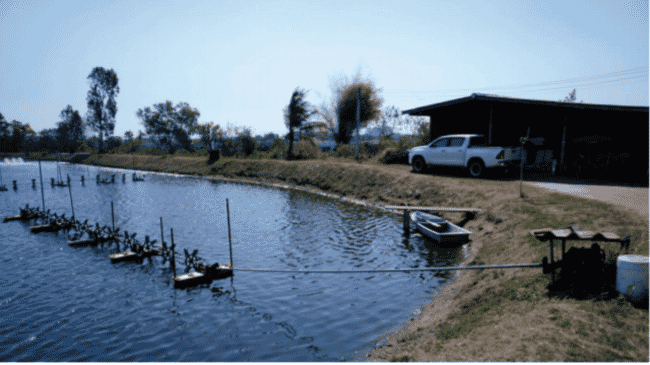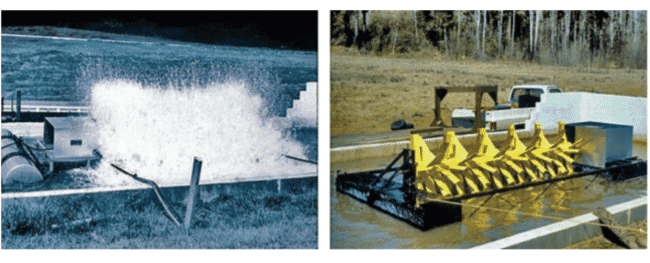
© Boyd and McNevin
So suggest the authors of a new study, which analyses the aeration devices used in six shrimp farms in Thailand, the amount of energy used to power them and possible alternatives.
Aerators, which allow for greater feed inputs and increased shrimp stocking densities, come in designs including the paddlewheel, vertical turbine, diffuser and venturi. In Asian shrimp farms, the authors note, it also is popular to mount paddlewheels on floats and drive them with a power unit installed beside the pond. Commonly known as long‐arm aerators, these devices are driven by 2‐ to 5‐hp electric motors or 7.5‐ to 16‐hp diesel engines. While they are available from aerator manufacturers, they are often assembled from aerator parts by farmers.
All the farms in the survey had long‐arm aerators powered by electricity and fabricated by farm staff from new or used aerator parts. Four of the six farms also had venturi aerators, diffuser aerators, or both.
The most common practice observed at the six farms was to operate about 50 percent of long‐arm aerators during daytime and 100 percent during the night. Venturi aerators were used mainly at night. One farm operated diffusers 24 hours a day and another only when deemed necessary.
The researchers calculated that the range in energy use by aerators was 13.7–24.5 GJ per tonne of shrimp produced, with an average of 18.1 GJ per tonne. They noted “excessive amounts of installed aeration capacity in Asian shrimp ponds” and reflected that this “may result from farmers wanting to protect against unexpected low dissolved oxygen concentrations in the absence of dissolved oxygen monitoring to verify effectiveness”.
“There was a rather wide range in energy use per tonne of shrimp. In some instances, values were between 12 and 15 GJ/t shrimp. By staging daily aerator operation, it should be possible to lower energy use to 10–15 GJ/t even with aerators in current use in Asia. Adoption of factory‐made aerators would decrease energy use at farms presently using farm‐made, long‐arm aerators, and particularly those powered by diesel engines. Finally, more energy efficient aerators could be made if manufacturers would use available information to improve aerator SAE. It seems reasonable to expect that a serious effort by the shrimp farming sector could reduce average energy use for aeration to 8 GJ/t or less,” the researchers observe.
They also note that around 5 million tonnes of farmed shrimp are produced annually, and at least 70 percent of this production is from aerated ponds. As a result, they calculate that a reduction of aeration energy use would save the industry about $87.5 million a year as well as lessen carbon dioxide emissions by around 460,000 tonnes CO2 equivalent per year.
The researchers admit to being puzzled why Asian shrimp farmers do not use factory‐made aerators more and why the paddlewheel design now favoured by US catfish producers has not been adopted in Asia. They concede that long‐arm aerators can be fabricated by a farmer at less than the purchase cost of a factory‐made one, while an aerator incorporating the design features of a US‐made catfish pond aerator would be more expensive than the designs in present use.

© Boyd and McNevin
“However, the investment cost of an aerator is only a part of the cost of aeration. Thought should be given to oxygen‐transfer efficiency, service life, and maintenance cost of aerators. The long‐term benefits of higher quality, greater efficiency, longer service life, and less maintenance seem totally ignored. This probably is not a cultural characteristic, because it is a phenomenon common to shrimp farmers worldwide. It might result because shrimp culture is potentially very profitable but also carries a high risk of failure. Maybe, shrimp farmers want to limit the long‐term investment as much as possible to minimize losses when a crop failure inevitably occurs,” they suggest.
Six tips for efficient aeration
The study ends with six recommendations to make the use of aerators more efficient:
- Do not install more aeration than necessary. A good rule is about 2 hp/t for floating, electric aerators and 3 hp/t for long‐arm aerators.
- Reduce energy use by matching motors or engines with loads imposed by aerators.
- Further reduce energy use by staging operation schedule with proportion of installed aeration capacity in use and daily hours of operation increasing from stocking to harvest with respect to the amount of shrimp biomass.
- Promote use of factory‐fabricated paddlewheel aerators rather than relying on farm‐made aerators.
- Instigate a program to show paddlewheel aerator manufacturers the benefit of more efficient paddle and paddle unit design.
- Encourage the adoption of the 10‐hp catfish pond aerator used in the United States or smaller versions of this aerator. It is not under a patent, and it could be manufactured in Asia.
Further information
The full study was published in the Journal of the World Aquaculture Society, under the title Aerator energy use in shrimp farming and means for improvement, and the research was funded by the Gordon and Betty Moore Foundation.




